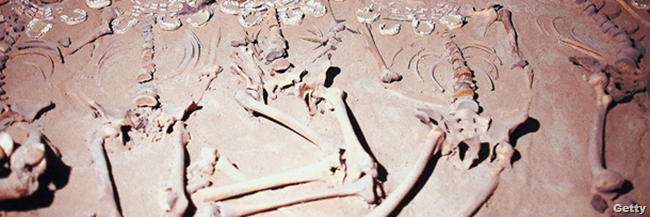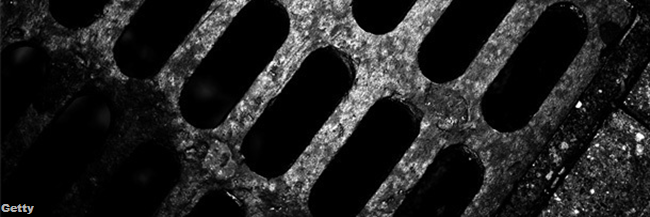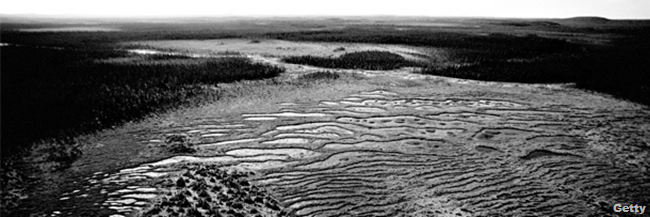The 7 Most Terrifying Archaeological Discoveries
By Adam Wears & S. McClelland-Crosby, Cracked.com, 30 May 2012.
By Adam Wears & S. McClelland-Crosby, Cracked.com, 30 May 2012.
No professional position, aside from perhaps police officer and horny pizza delivery boy, is more frequently misrepresented in film than archaeologist. In movies, archaeologists are all dashing figures, risking life and limb in the pursuit of knowledge while arcane artefacts and ancient traps besiege their efforts. Or else they're perpetually opening sealed, cursed tombs and stumbling into the haunted caves of unspeakable evils in the name of science. But in reality, we all know archaeology is nothing like that. Obviously.
It's way more terrifying.
7. The Screaming Mummies
In 1886, Gaston Maspero, the head of the Egyptian Antiquities Service, was doing like he do - just taking mummies out of their sarcophagi, unwrapping them, dictating all kinds of boring notes - when he came across an unusually plain burial box. Unlike the kings and queens he'd been working with for most of his career, this particular box didn't give any information as to the identity of the stiff inside. Even stranger, the body was wrapped in sheepskin, which was considered unclean by ancient Egyptians. When he finally uncovered it, Gaston also found that the corpse's hands and feet had been bound for some unspeakable reason. And then, as he slowly panned his gaze upward - presumably while violins screeched out a dramatic, building score - he found this screaming, undead face looking back at him:
Because of the strange coverings, the bound hands and the seemingly tortured expression, experts theorized that the body (creatively named Unknown Man E) had been poisoned, buried alive or otherwise tortured before his untimely death. Now that we've done extensive studies on mummification and seen quite a few more intact examples, however, we understand how silly that theory was. Not because the "screaming mummy" was just a fluke, but because they're all screaming all the time.
If the jaw isn't strapped shut when a body is mummified, it naturally falls open during the process of decay, leaving a permanent "scream." Most modern burial practices account for this - the ghost of Jacob Marley, Scrooge's business partner in A Christmas Carol, is always shown with that weird headband/chinstrap for precisely this reason. But not all cultures take closing the jaw into account, or sometimes the knots tying the mouth shut just slip. That's why, since Unknown Man E, there have been several more "screaming" mummies found in various digs all around the world.
Yep. Apparently the screaming torment of the undead just ain't a thing.
But really, when you think about it, the rational explanation for the screaming mummies doesn't actually make the finds less impressive. If anything, we have more respect than ever for archaeologists, who we now realize are constantly stumbling into strange, sealed tombs to find stuff like this thing staring at them from the shadows:
And when they come face to face with the scariest props from Raiders of the Lost Ark, said archaeologists not only inexplicably refrain from exploding in a big salty ball of fear urine, but calmly stride over, grab the damn thing by the neck and drag the bastard out into the sun for science to take a good, long gander at.
And that's why we propose a new field of study that devotes all of its research hours just to figuring out how to measure balls that size.
6. The Mass Grave of the Headless Vikings
Archaeologists were digging up the side of a boring old roadway in Dorset when suddenly, instead of "more cobblestones" and "maybe part of a plough," they unearthed something a bit more exciting: a mass grave containing the headless remains of 54 Viking mercenaries. Instead of rightfully interpreting the pit as some kind of ancient "Caution: Predator Hunting Grounds" warning sign and getting the hell out of there, the archaeologists set about carefully recording the positions of the bones. As they did so, the researchers began to notice something unusual about the placement. Namely, that the leg and arm bones, heads and torsos were all neatly arranged into their own separate piles.
So what happened?
Our leading theory is that the Vikings found a Hellraiser-style puzzle box and accidentally unleashed a horde of Middle Ages cenobites.
The archaeologists' (substantially less plausible) initial theory was that, after being captured by the occupants of a local village that somehow survived the Viking attack, the assailants themselves were murdered, with their corpses then being stripped naked and dismembered by the villagers, who also took a few heads with them as, like, fun-time souvenirs or something.
We're trying not to pass judgment here.
But that doesn't explain why the unfortunate Vikings were beheaded by strange, precise sword blows delivered from the front, instead of the usual hack-jobs to the back of the neck that accompany normal beheadings. In fact, the archaeologists themselves later revised their theory, admitting that the Vikings were probably not torn apart by a brutally violent mob bent on revenge, but may have been sacrificed in a highly controlled and ritualistic manner not consistent with the surrounding culture of the time. As seems to be the case in this nightmare-inducing photo:
So yeah, in short: Viking Hellraiser.
5. The Mount Owen Moa
In 1986, an expedition descended on Mount Owen in New Zealand with the intention of exploring the vast network of caves that dwell deep beneath the mountain.
Huh.
Ominous setting, isolated expedition, vast network of unexplored caves. Yep, sounds like somebody's filming a sequel to The Descent, all right. And true to horror cliché form, the team was excavating a path between two caves when they found something...disturbing:
Still connected to shredded fragments of skin, as though fresh.
And attached to this thing:
Imagine peering through the darkness, with only the tiny, wavering beam of your flashlight picking out the world in front of you, when you're confronted by that: a very large, very claw-happy foot from some sort of hell-beast that looks like it probably died recently. And you're down there, trapped in an underground cave system, not knowing whether its bloodthirsty relatives are nearby. We mean, best case scenario, it's going to grant you four ironically cursed wishes that will ultimately kill you, right?
It turns out that the team had stumbled onto the 3,000-year-old remains of an upland moa, a flightless bird that somehow went extinct despite possessing claws that would make a velociraptor jealous. Here's the naturally mummified, 600-year-old head of a different moa:
Gah! It's like The Dark Crystal come to terrible un-life!
And just like the devil's claw above, the background story behind this discovery reads like a classic horror movie plot line: It was originally discovered in another New Zealand cave back in 1863, by James Campbell. And then, with no explanation, the specimen up and vanished for a number of years, until it resurfaced and was sold to the director of Wellington's Dominion Museum by Campbell's great-great-grandson for the suspiciously low price of 5 pounds. Not listed on the receipt were: peace of mind, the remainder of his soul and a promise from the corpse that it would stop tormenting every single generation of the family that disturbed its slumber.
4. The Tomb of the Sunken Skulls
In 2009, archaeologists were excavating the bottom of a prehistoric dry lake bed in Motala, Sweden, when they stumbled upon the foundations of a mysterious stone structure...sealed at the bottom of an ancient friggin' lake. Rather than turning tail and running away so fast their legs spun uselessly in the air for a few minutes like a Scooby-Doo cartoon, the stupidly brave scientists started digging. They eventually unearthed the exact kind of stuff one expects from primitive mystery structures: animal bones, stone tools and, oh yeah - the 8,000-year-old skulls of 10 people, ranging in age from small children to the elderly.
And then they found an 11th skull buried deep within the ancient mud of the lake bottom.
And then they found fragments of one of the other skulls...deliberately lodged inside the cranium of the 11th skull.
Let's recap: For reasons that are unclear to us, some ancient society probably butchered 11 people in a stone hut at the bottom of a lake bed, and then put the pieces of one dead person's skull inside the brain space of another person, like the world's most godawfully horrifying nesting doll.
But the horror doesn't end there: Not only had somebody perhaps bashed one person's skull in with another person's skull, but, before being interred inside the tomb, several of the bodies had stakes driven through them and were then set alight. This didn't take careful deduction on the part of the excavators to discover: Two of the skulls were found with the stakes still embedded (and in one case, entirely melded with) them.
The official theories are all over the map, from bizarre funeral practices to a group of warriors mounting the skulls of their defeated opponents as war trophies. But we think differently: Maybe the mysterious prehistoric men who put the bones there in the first place were the good guys, just trying to put down an ancient vampire infestation.
By uh...by beating the vampires to death with the skulls of their loved ones, we guess? That's one of their weaknesses, right? Garlic, sunlight, holy water, being walloped upside the head with their own brother's severed head. You know: usual canon stuff.
3. The Sewer of Babies
A group of archaeologists excavating a sewer underneath a Roman/Byzantine bathhouse in Ashkelon, Israel, thought they had drawn the short end of the science stick, what with having to dig through ancient poo and all. Until they started turning up hundreds of thousands of tiny little bones, and realized just how screwed they really were. Any hope that they had just stumbled upon the remains of an old-timey Roman KFC and were not, in fact, about to be torn apart by itty bitty ghosts was shot when they then started finding skulls and realized, to their horror, that they were all standing waist-deep in a sewer specially designated for disposing of the corpses of new-born babies.
In all, the researchers found nearly 100 bodies, which, if you're keeping track, is roughly 100 more bodies than you want trapped inside an ancient, crumbling, pitch-black sewer with you. We wish we could tell you this was something slightly less disturbing than the implied charnel baby processing centre of the ancient world that it seems to be, but the truth is: No one knows for sure why the bones are down there. Or why this scientist is measuring it without screaming, like it ain't nothing.
At first, it was thought that the sewer was used just to dispose of female infants, which is awful but at least makes some kind of sense, as parents of the time period treated the lives of women with roughly the same respect and sanctity as toilet paper (i.e. they both wound up in the sewer when you were done with them). However, analysis of the bones showed that many of them were males - sweet, precious boys! The Roman's most suspiciously valued demographic - which implied that the bathhouse above might have been more of a quotation-marks-style "bathhouse," and that the whores were only disposing of male babies so that the females could be groomed for an auspicious life of whoring and baby dumping themselves.
2. The Bog People
Peat farmers in Northern Europe deserve your pity. In addition to generally having one of the most depressing jobs ever - peat not being nearly as fun to farm as, say, gold or ponies - in the course of their labours, they regularly stumble across soul-scarring shit like this:
OK, sure, that looks terrifying at first glance. But with some good counselling, you could get over that; those are just the remains of a normal burial, accidentally unearthed by the bog (the high acidity, low temperature and lack of oxygen preserve the bodies unusually, disturbingly well). These, on the other hand, spit right in the face of therapy:
Those images will only stop haunting your dreams when you fulfil your destiny and kill your family with a harvest scythe, like the whispering bog voices have just started politely asking you to do. The pictures are, unfortunately, exactly what they look like: murdered bodies offered up as part of some freaky bog people ritual. One corpse in particular, the "Grauballe Man," tells the story pretty clearly: He was put to death the winter after a bad harvest, there's evidence of stubble on his jaw (indicating he had been detained and not allowed to shave in the days before he was put to death) and his burial pit was right in the middle of a consecrated area.
That's right: He was sacrificed to the bog in return for a good harvest...
And fabulous hair.
So it turns out The Wicker Man was less of a ridiculously implausible B-horror flick and more of a tastefully understated docu-drama about the religious rites of rural farmers.
1. Ancient Chemical Warfare
In 1933, archaeologist Robert du Mesnil du Buisson was conducting a dig in the area of Dura-Europos, where ancient Persians laid siege to their long-time enemies, the Romans. During the excavation, du Mesnil found several tunnels, which is pretty much par for the course in a siege situation. A little out of the ordinary, however, was the haphazard pile of 19 Roman soldiers he found in one of those tunnels, all looking as though they died while fleeing something. So what was at other end of the tunnel that could terrify and ultimately murder 19 Roman soldiers so quickly?
A single Persian soldier, found clutching desperately at his armour, forever preserved in that panicked moment.
Add to the strangeness the fact that there were traces of sulphur and bitumen all along the walls, and the implication is clear: one terrified Persian who died clawing frantically at his own body, 19 Romans who died fleeing from his direction, sulphurous emanations in the walls?
That's demon possession, man. Those are some classic, Supernatural-style demon shenanigans right there.
All right, so maybe there are other, slightly more plausible theories. A reinvestigation of the records of the original dig, conducted by archaeologist Simon James, indicates that the deaths were actually due to one of the earliest attempts at chemical warfare.
"The Romans heard the Persians working beneath the ground and steered their tunnel to intercept their enemies. The Roman tunnel was shallower than the Persian one, so the Romans planned to break in on the Persians from above. But there was no element of surprise for either side: The Persians could also hear the Romans coming.
"So the Persians set a trap. Just as the Romans broke, through, James said, they lit a fire in their own tunnel. Perhaps they had a bellows to direct the smoke, or perhaps they relied on the natural chimney effect of the shaft between the two tunnels. Either way, they threw sulphur and bitumen on the flames. One of the Persian soldiers was overcome and died, a victim of his own side's weapon. The Romans met with the choking gas, which turned to sulphuric acid in their lungs."
Work on the Persian tunnel dig has been renewed in light of this intriguing development, including a reopening of the original site where 20 ancient warriors died in fear and agony. It looks like this:
Balls, archaeologists. Pure balls. However much we pay you to taunt furious ghosts just so we can have fun stuff to look at in museums, you totally deserve a raise.






For those who are clumsy or accident, the fact that it is made with aluminum unibody construction is a huge relief.
ReplyDeleteThe farther you go and more the zombies that you bang away with
this car game, the more money you earn. Age of Wonders II: The Wizard's
Throne Axis & Allies.
Also visit my website :: doom 3